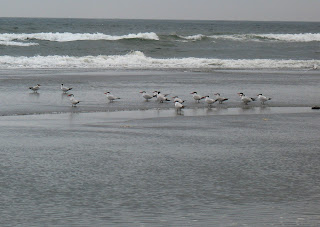 |
| I waded through numerous flocks of birds on Ocean Park beach, this one made up primarily of Caspian Terns and Heermann's Gulls (darker) |
 |
| I enjoyed watching a pair of Lesser Yellowlegs while hanging out near a tide pool |
The nice weather this afternoon allowed me to visit some of
the COASST beaches along the Long Beach Peninsula (WA) to get a sense
of the places where these folks survey. Making my way through the long and flat
beaches (they aren’t kidding when they say LONG beach), I waded through several
impressive gatherings of birds. I’m still getting used to the, shall I say,
unpleasant squawk of the Caspian Tern, although they are beautiful birds. After
finding a little tide pool, I sat and watched two Lesser Yellowlegs searching
for food in the shallow water. And then
I caught myself scanning the sand for any feathers, unusual looking lumps, or
out-of-place patches of color. Oh boy, could it be that as I’ve joined several
surveys over the past few weeks the COASST mentality is slowing taking hold? Have
I become habituated to scan the beach for post-mortem material? Kathleen would
be proud!
 |
| I'm not sure what this is - but it definitely isn't alive |
Ahhaaa! And there it was – a dead bird lying off in the
distance on the sand. Rushing over like a kid in a candy store (I know, not the best metaphor…), I studied the bird with my eyes while taking several photographs. Had I been on an official COASST survey I could have utilized the program tools provided to figure out exactly what this bird was and note its location. I had to wonder what it was, how it got there, and what had happened to it. A strong sense of curiosity takes over when you encounter these birds, something I’ve heard about quite a bit as I’ve visited with COASST members. Today, anyway, I had to leave with little answers – hoping that soon a resident COASSTer would find this bird again and do what they do best – fill in a small but significant part of a much larger puzzle.














































